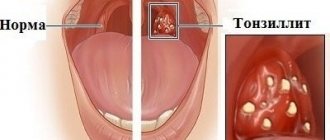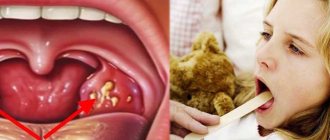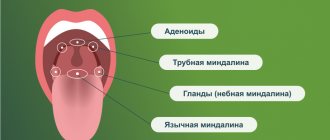Causes of tonsillitis in children
The disease occurs due to the ingress of bacteria or viruses. Tonsillitis is often caused by streptococcus bacteria. The disease is also caused by adenoviruses, influenza and parainfluenza viruses, herpes, etc.
Other reasons:
- staphylococcus, pneumococcus, hemophilus influenzae and other microbial associations;
- enterovirus infection;
- mushrooms;
- parasites – membrane and intracellular (mycoplasma and chlamydia);
- disruption of the process of self-cleaning of lacunae against the background of restructuring of lymphoid tissue and dysbiosis of the respiratory tract;
- a single or multiple history of tonsillitis;
- ARVI, sinusitis, adenoiditis, caries, stomatitis, periodontal disease;
- anatomical features of the pharyngeal part of the lymphatic system - deep and narrow lacunae, adhesions, multiple fissure passages;
- burdened by concomitant diseases - food allergies, perinatal pathologies, rickets, impaired breathing through the nose, intestinal infections and other factors that reduce immunity.
Tonsillitis in children
Among the microbial flora involved in the development of tonsillitis in children, streptococci (beta-hemolytic streptococcus of group A, viridans streptococcus), staphylococci, Haemophilus influenzae, pneumococcus, and various microbial associations are of primary importance. The frequency of isolation of hemolytic streptococcus from the throat during tonsillitis ranges from 30% to 60-80% of cases, and an increased titer of antistreptococcal antibodies (antistreptolysin-0) is found 4 times more often than in healthy children. Among other representatives of the pathogenic flora in children with tonsillitis, there are pathogens of adenoviral and enteroviral infections; parainfluenza, influenza and herpes viruses, fungi, intracellular and membrane parasites (chlamydia, mycoplasma). Against the background of morphological restructuring of lymphoid tissue and dysbiosis of the upper respiratory tract, the process of self-cleaning of tonsil lacunae is disrupted, which contributes to the proliferation of pathogens and the development of chronic inflammation.
In most cases, the onset of chronic tonsillitis in children is preceded by a single or repeated history of tonsillitis. Activation of opportunistic flora and an increase in its virulence in the tonsils occurs under the influence of hypothermia, viral and other diseases. Penetrating into the parenchyma of the tonsils, blood and lymphatic vessels, pathogens begin to produce exo- and subdotoxins, initiating the development of toxic-allergic reactions. Against the background of impaired local circulation, increased permeability of the vascular wall, and local immunosuppression, another exacerbation of tonsillitis in children develops. Due to recurrent inflammation, the parenchyma of the tonsils undergoes hyperplasia, sometimes atrophy, sclerosis, and scarring.
In some cases, children experience a non-anginal form of tonsillitis, which gradually develops under the guise of ARVI, adenoiditis, sinusitis, stomatitis, caries, periodontal disease, i.e. the involvement of the palatine tonsils in the infectious-inflammatory process occurs secondary.
The occurrence of tonsillitis in children is facilitated by the anatomical and topographical features of the lymphoid apparatus of the pharynx: narrow and deep lacunae of the tonsils, multiple slit-like passages, adhesions that make it difficult to empty the lacunae. With tonsillitis in children, the palatine tonsils do not perform their barrier function, but, on the contrary, become a constant chronic source of infection and a factor in the general sensitization of the body.
Tonsillitis often affects children with a burdened concomitant background: perinatal pathology, food allergies, rickets, lymphatic-hypoplastic diathesis, nasal breathing disorders, hypovitaminosis, intestinal infections and other factors that reduce the body's defenses.
Types of disease
- Spicy. Most often, the acute form develops after suffering from acute respiratory viral infection, due to reduced immunity. Source: A.D. Vetrova Acute tonsillitis in children: a pediatrician’s point of view // Pediatric pharmacology, 2014, v. 11, no. 2, pp. 61-64
- Chronic. Occurs after relapses if the patient has not fully recovered. Diseases in the mouth, nose, and structural features of the tonsils contribute to the development of chronic tonsillitis. Source: https://www.ncbi.nlm.nih.gov/pmc/articles/PMC6248716/ Raja Kalaiarasi, Kalaivani S Subramanian, Chellappa Vijayakumar and Ramakrishnan Venkataramanan Microbiological Profile of Chronic Tonsillitis in the Pediatric Age Group // Cureus. 2022 Sep; 10(9): e3343
Symptoms of the disease
The main symptoms of tonsillitis in children that require immediate treatment are:
- pain when swallowing and yawning;
- heat;
- general intoxication of the body (weakness, decreased appetite, headaches);
- swelling and redness of the tonsils;
- formation of whitish or yellowish plaque on the tonsils;
- blisters, sores on the throat;
- loss of voice, hoarseness;
- bad breath;
- enlarged and painful lymph nodes (this sign can indicate not only tonsillitis, it accompanies many other diseases in children).
Features of symptoms and treatment
The incubation period for the development of a purulent process is usually 5-7 days.
In a weakened child, symptoms may appear earlier. The disease begins with a sharp increase in temperature to 38.5°-39°. Chills, body aches, and weakness occur. It hurts the child to swallow and talk. Gradually the pain intensifies and is felt even at rest.
The severity of symptoms depends on the type of purulent sore throat in the child. In addition to the main ones, the following symptoms may also appear:
- swelling of the submandibular lymph nodes;
- swelling of the larynx and neck;
- headache;
- loss of voice;
- abdominal pain, vomiting, diarrhea;
- ear pain;
- snoring in your sleep.
Among other things, sometimes skin rashes appear due to intoxication of the body.
The difference between a sore throat and ARVI
Unlike ARVI, with purulent tonsillitis the child does not have a runny nose. The main signs of the disease are high fever, sore throat, and abdominal pain.
Note: If a child has a red throat, with a runny nose and cough, this is not a sore throat, but a viral infectious disease. Antibiotics are powerless against viruses, so they are not prescribed for ARVI, but only means to relieve symptoms. After 1 week, the virus dies and self-healing occurs.
Purulent sore throat in children does not go away on its own. If antibacterial treatment is not carried out, this leads to the occurrence of such serious diseases as meningitis, myocarditis, and pyelonephritis. Often, especially in children 2-5 years old, a complication of sore throat is inflammation of the middle ear (otitis media) and inflammation of the respiratory tract. Even simple catarrhal tonsillitis can develop into chronic tonsillitis with subsequent serious complications.
Treatment with antibiotics allows you to quickly cope with the disease.
Video: Doctor Komarovsky: tonsillitis in children
Diagnostic methods
During the consultation, the doctor will examine the patient’s throat and palpate the lymph nodes. The examination should be carried out by a pediatrician and pediatric ENT specialist. In case of decompensation of the chronic form, the child requires consultation with a pediatric cardiologist, rheumatologist, nephrologist, because tonsillitis can cause concomitant diseases. To rule out pockets of infection in the oral cavity, the child should be examined by a dentist. Laboratory and instrumental studies are also prescribed:
- blood and urine tests;
- pharyngoscopy;
- blood test to determine C-reactive protein;
- definition of ASL-O;
- bacterial culture from the pharynx for flora.
If there are difficulties in making a diagnosis, additional studies may be required - ECG, x-ray of the sinuses, etc.
FAQ
Can pharyngitis be treated at home?
Pharyngitis usually does not require hospitalization (hospital treatment). You can treat strep throat at home on your own by using topical remedies to relieve sore throat and sore throat. If, after self-treatment, the sore throat does not go away within 3 days, then you should consult a doctor. If you have a fever in addition to a sore throat, you should immediately consult a doctor.
Which doctor should I contact if I have a sore throat?
If you have a sore throat, sore throat, or difficulty swallowing, you should first consult a therapist or pediatrician if you are a child. If there are indications, the doctor will prescribe a consultation with an ENT doctor.
Very severe sore throat. Are you sure I don't have a sore throat?
With pharyngitis, the pain syndrome may be more pronounced than with tonsillitis (tonsillitis). To treat pharyngitis, it is good to use a remedy that has an analgesic effect, for example Tantum® Verde. To exclude sore throat (streptococcal tonsillitis) or streptococcal pharyngitis, it is recommended to conduct a rapid test (streptotest).
Do you need an antibiotic for pharyngitis?
The antibiotic is indicated ONLY for bacterial pharyngitis. For a quick diagnosis, perform a rapid test for streptococcus. It will allow you to exclude or confirm the bacterial nature of pharyngitis. If streptococcus is detected, the doctor will prescribe antibiotics.
Is strep throat contagious?
Most often, strep throat is a viral disease, so a person can shed the virus and infect other people. A sick person is contagious, so you should stay at home until you recover.
What happens if pharyngitis is not treated?
Complications may arise. If pharyngitis is not treated, complaints persist much longer, inflammation does not go away and begins to become chronic.
Is it possible to get vaccinated for pharyngitis and when?
Against the background of an acute illness or exacerbation of chronic pharyngitis, vaccination is contraindicated. Wait until you have fully recovered and then you can get vaccinated. The exception is vaccination against influenza. It can be done when the temperature is normalized, i.e. There is no need to wait for all symptoms to disappear.
Is it possible to eat cold food if you have a sore throat?
If you have pharyngitis, it is not recommended to eat very cold foods, including ice cream. This can increase inflammation and slow down recovery.
Treatment of tonsillitis in children
With properly selected medications, treatment of tonsillitis in a child takes about a week. The patient is prescribed bed rest, plenty of fluids and a gentle diet, excluding spicy and fatty foods. Medicines are selected according to the type of tonsillitis, accompanying symptoms, and the age of the child. Medicines should only be prescribed by a doctor.
The treatment program includes:
- painkillers;
- washing and rinsing;
- sprays and lozenges;
- physiotherapy. Source: T.V. Spichak Diagnosis and treatment of tonsillitis in children from the perspective of evidence-based medicine // Issues of modern pediatrics, 2010, vol. 9, no. 2, pp. 130-135
Antibiotics are prescribed to children only in severe cases, as they cause side effects (abdominal pain, diarrhea, etc.).
Removal of the tonsils (tonsillectomy) is used in exceptional cases, if frequent relapses of the disease are observed, conservative treatment is ineffective, and complications from internal organs are identified.
In case of exacerbation of the chronic form of tonsillitis, the child requires bed rest, diet correction with the exception of fatty, fried, smoked, sweet foods, as well as drug therapy, which includes antibiotics, vitamins, desensitizing drugs, and immunomodulators.
Necessary:
- wash the lacunae of the palatine tonsils with antiseptics;
- treat the back wall of the pharynx and tonsils with solutions of fucorcin, Lugol;
- the child should regularly gargle with antiseptics and herbal decoctions.
You also need to do inhalations, use antiseptic aerosols, and take antimicrobial lozenges.
Physiotherapy may be prescribed :
- Ural Federal District;
- UHF;
- microwave;
- ultraphonophoresis;
- laser therapy.
Complications of the disease:
- descent of purulent infection into the heart sac;
- abscess;
- bleeding from the tonsils;
- eustacheitis;
- otitis;
- purulent inflammation;
- swelling of the larynx with the development of asphyxia, which can be fatal.
Symptoms of acute tonsillitis in children
- the disease is characterized by a sharp rise in temperature up to 40 degrees
- the child may complain of a sore throat and refuse to eat or drink because of this
- the child is lethargic and capricious, contact with him may be difficult
Throat with sore throat
When examining the throat, the picture may differ depending on the pathogen, the shape of the lesion and the localization of the process.
Lymph nodes are enlarged and painful.
But basically in a child’s throat you can see red mucous membranes, enlarged and swollen tonsils with or without plaques of various types.
When the adenoid is inflamed, there is difficulty breathing through the nose; the child breathes mainly through the mouth. This is due to enlargement of the pharyngeal tonsil due to swelling and obstruction of the nasopharynx.
In children, the adenoid becomes inflamed regularly and therefore becomes chronic.
Clinical recommendations for disease prevention
The main methods of preventing tonsillitis in children are compliance with sanitary and hygienic measures (avoiding contact with patients and their things, washing hands, using a scarf and hand sanitizers) and strengthening the immune system (hardening, playing sports, etc.).
Tonsillitis is a common disease in children and adults, which without proper treatment can become chronic. If you notice symptoms of illness in your child, immediately contact the children's medical department.
Sources:
- HELL. Vetrova. Acute tonsillitis in children: a pediatrician’s point of view // Pediatric pharmacology, 2014, vol. 11, no. 2, pp. 61-64.
- https://www.ncbi.nlm.nih.gov/pmc/articles/PMC6248716/ Raja Kalaiarasi, Kalaivani S Subramanian, Chellappa Vijayakumar and Ramakrishnan Venkataramanan. Microbiological Profile of Chronic Tonsillitis in the Pediatric Age Group // Cureus. 2022 Sep; 10(9): e3343.
- T.V. Spichak. Diagnosis and treatment of tonsillitis in children from the standpoint of evidence-based medicine // Issues of modern pediatrics, 2010, vol. 9, no. 2, pp. 130-135.
The information in this article is provided for reference purposes and does not replace advice from a qualified professional. Don't self-medicate! At the first signs of illness, you should consult a doctor.
How common is pharyngitis?
Pharyngitis, like a common ARVI (viral infection), occurs quite often. The incidence rate increases during the season from September to May, with a peak in February and March. A decrease in the incidence of pharyngitis by 3-5 times is observed in the summer months.10,11
Acute pharyngitis occurs more often in childhood than in adults. Children under 5 years of age suffer viral infections, including pharyngitis, 6-8 times a year.8,9
In the first year of visiting a preschool institution, the incidence of the disease is 10-15% higher than in children at home. But, unfortunately, “home” children subsequently get sick more often at school age.








